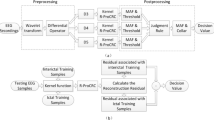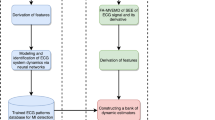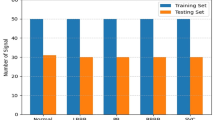Abstract
In the hereby work, we present the use of sparse representation and overcomplete dictionary learning method for examining the case of anomaly detection in an electrocardiographic record. The above mentioned signal was introduced in a form of correct electrocardiographic morphological structures and outliers which describe different sorts of disorders. In the course of study, two sorts of dictionaries were used. The first consists of atoms created with the use of differently parameterized analytic Gabor functions. The second sort of dictionaries uses the modified Method of Optimal Directions to find a dictionary reflecting proper structures of an electrocardiographic signal. In addition, in this approach, the condition of decorrelation of dictionary atoms was introduced for the sake of gaining more precise and optimal representation. The dictionaries obtained in these two ways became a basis for the analyzed sparse representation of electrocardiographic record. During the anomaly detection process, which was based on decomposition of the analyzed signal into correct values and outliers, a modified alternating minimization algorithm was used. A commonly accessible base of data of electrocardiograms, that is MIT-BIH Arrhythmia Database, was utilized to examine the conduct of the recommended method. The effectiveness of the solution, which validated itself in searching of anomalies in the analyzed electrocardiographic record, was confirmed by experiment results.






Similar content being viewed by others
References
Sanamdikar ST, Hamde ST, Asutkar VG (2015) A literature review on arrhythmia analysis of ECG signal. Int Res J Eng Technol 2(3):307–312
Parák J, Havlík J (2011) ECG signal processing and heart rate frequency detection methods. In: Proceedings of the 2011 international conference technical computing, pp 1–6
Einthoven W (1923) The string galvanometer and the measurement of the action currents of the heart. Nobel Lecture
Garcia TB (2015) Introduction to 12-lead ECG: the art of interpretation, 2nd edn. Jones and Bartlett Publishers Inc, Sudbury
Ashly EV, Sreekumar K (2017) A survey on approaches for ECG signal analysis with focus to feature extraction and classification. In: Proceedings of the 2017 international conference on inventive communication and computational technologies, pp 140–144. https://doi.org/10.1109/icicct.2017.7975175
Daskalov IK, Christov H (1999) Electrocardiogram signal preprocessing for automatic detection of QRS boundaries. Med Eng Phys 21:37–44. https://doi.org/10.1016/s1350-4533(99)00016-8
de Chazal P, O’Dwyer M, Reilly RB (2004) Automatic classification of heartbeats using ECG morphology and heartbeat interval features. IEEE Trans Biomed Eng 51(7):1196–1206. https://doi.org/10.1109/tbme.2004.827359
Tang X, Lan S (2014) A frame work of automatic analysis system of electrocardiogram signals. Int J Signal Process Image Process Pattern Recognit 7(2):211–222
Shyu LY, Wu YH, Hu W (2004) Using wavelet transform and fuzzy neural networks for VPC detection from the Holter ECG. IEEE Trans Biomed Eng 51(7):1269–1273. https://doi.org/10.1109/iembs.1999.804366
Poli R, Cagnoli S (1995) Genetic design of optimum linear and non-linear QRS detection. IEEE Trans Biomed Eng 42:1137–1141. https://doi.org/10.1109/10.469381
Deng Z, Zhang S, Yang L, Zong M, Cheng D (2016) Sparse sample self-representation for subspace clustering. Neural Comput Appl 29:1–7. https://doi.org/10.1007/s00521-016-2352-2
Lehnert W, Soderland S, Aronow D, Feng F, Shmueli A (1995) A inductive text classification for medical applications. J Exp Theor Artif Intell 7(1):49–80. https://doi.org/10.1080/09528139508953800
Roopa CK, Harish BS (2017) A survey on various machine learning approaches for ECG analysis. Int J Comput Appl 163(9):25–33
Lei WK, Li BN, Dong MC, Vai MI (2007) AFC-ECG: an adaptive fuzzy ecg classifier. In: Saad A, Dahal K, Sarfraz M, Roy R (eds) Soft computing in industrial applications, vol 39. Springer, Berlin, pp 189–199
Behadada O, Chikh MA (2013) An interpretable classifier for detection of cardiac arrhythmias by using the fuzzy decision tree. Artif Intell Res 2(3):45–58
Ceylan R, Ozbay Y, Karlik B (2009) A novel approach for classification of ECG arrhythmias: type-2 fuzzy clustering neural network. Expert Syst Appl 36(3):6721–6726
Vishwa A, Lal M, Dixit S, Vardwaj P (2011) Classification of arrhythmic ECG data using machine learning techniques. Int J Interact Multimedia Artif Intell 1(4):67–70
Anuradha B, Reddy V (2008) ANN classification of cardiac arrhythmias. ARPN J Eng Appl Sci 3(3):1–6
Kampouraki A, Manis G, Nikou C (2009) Heartbeat time series classification with support vector machines. IEEE Trans Inf Technol Biomed 1(4):512–518
Nasiri JA, Naghibzadeh M, Yazdi HS, Naghibzadeh B (2009) ECG arrhythmia classification with support vector machines and genetic algorithm. In: Third UKSim European symposium on computer modeling and simulation
Priyadharshini V, Kumar SS (2015) An enhanced approach on ECG data analysis using improvised genetic algorithm. Int Res J Eng Technol 2(5):1248–1256
Dalal S, Birok R (2016) Analysis of ECG signals using hybrid classifier. Int Adv Res J Sci Eng Technol 3(7):89–95
Bensujin CK, Hubert C (2014) Detection of ST segment elevation myocardial infarction (STEMI) using bacterial foraging optimization technique. Int J Eng Technol 6(2):1212–1224
Finlay D, Bond R, Kennedy A, Guldenring D, Moran K, McLaughlin J (2015) The effects of electrode placement on an automated algorithm for detecting ST segment changes on the 12-lead ECG. Comput Cardiol 42:1161–1164
Ning X, Selesnick IW (2013) ECG enhancement and QRS detection based on sparse derivatives. Biomed Signal Process Control 8:713–723. https://doi.org/10.1016/j.bspc.2013.06.005
Agyemang M, Barker K, Alhajj R (2006) A comprehensive survey of numeric and symbolic outlier mining techniques. Intell Data Anal 10(6):521–538
Hodge V, Austin J (2004) A survey of outlier detection methodologies. Artif Intell Rev 22(2):85–126. https://doi.org/10.1007/s10462-004-4304-y
Chandola V, Banerjee A, Kumar V (2009) Anomaly detection: a survey. ACM Comput Surv 41(3):1–72
Andrysiak T (2016) Machine learning techniques applied to data analysis and anomaly detection in ECG signals. Appl Artif Intell 30:610–634. https://doi.org/10.1080/08839514.2016.1193720
Adler A, Elad M, Hel-Or Y, Rivlin E (2015) Sparse coding with anomaly detection. J Signal Process Syst 79(2):179–188. https://doi.org/10.1007/s11265-014-0913-0
Białasiewicz JT (2004) Falki i aproksymacje. WNT, Warszawa
Gazi O (2018) Understanding digital signal processing. Springer, Singapore. https://doi.org/10.1007/978-981-10-4962-0_2
Mallat SG (1989) A theory for multiresolution signal decomposition: the wavelet representation. IEEE Trans Pattern Anal Mach Intell 11(7):674–693. https://doi.org/10.1109/34.192463
Rubinstein R, Bruckstein M, Elad M (2010) Dictionaries for sparse representation modeling. Proc IEEE 98(6):1045–1057. https://doi.org/10.1109/JPROC.2010.2040551
Mallat S, Zhang Z (1993) Matching pursuits with time-frequency dictionaries. IEEE Trans Signal Process 41(12):3397–3415
Gribonval R, Schnass K (2008) Dictionary identifiability from few training samples. In: Proceedings of 16th European signal processing conference
Engan K, Aase SO, Husoy HJ (1999) Method of optimal directions for frame design. Proc IEEE Int Conf Acoust Speech Signal Process 5:2443–2446. https://doi.org/10.1109/ICASSP.1999.760624
Aharon M, Elad M, Bruckstein A (2006) K-SVD: an algorithm for designing overcomplete dictionaries for sparse representation. IEEE Trans Signal Process 54(11):4311–4322
Xie S, Krishnan S (2012) Learning sparse dictionary for long-term biomedical signal classification and clustering. In: Proceedings of the international conference on information science, signal processing and their applications (ISSPA), pp 1118–1123. https://doi.org/10.1109/ISSPA.2012.6310458
Adamo A, Grossi G (2011) A fixed-point iterative schema for error minimization in k-sparse decomposition. In: Proceedings of the IEEE international symposium on signal processing and information technology (ISSPIT), pp 167–172. https://doi.org/10.1109/ISSPIT.2011.6151554
Kalaji I, Balasundaram K, Umapathy K (2015) Discriminative sparse coding of ECG during ventricular arrhythmias using LC-K-SVD approach. In: Proceedings of the international conference of the IEEE engineering in medicine and biology society (EMBC), pp 5211–5214. https://doi.org/10.1109/EMBC.2015.7319566
Elad M (2010) Sparse and redundant representations: from theory to applications in signal and image processing. Springer, Berlin. https://doi.org/10.1007/978-1-4419-7011-4_2
Bruckstein AM, Donoho DL, Elad M (2009) From sparse solutions of systems of equations to sparse modeling of signals and images. J SIAM Rev 51(1):34–81. https://doi.org/10.1137/060657704
Davis G, Mallat S, Avellaneda M (1997) Adaptive greedy approximations. J Constr Approx 13:57–98. https://doi.org/10.1007/BF02678430
Tropp JA (2004) Greed is good: algorithmic results for sparse approximation. IEEE Trans Inf Theory 50(10):2231–2242. https://doi.org/10.1109/TIT.2004.834793
Boyd S, Parikh N, Chu E, Peleato B, Eckstein J (2010) Distributed optimization and statistical learning via the alternating direction method of multipliers. Found Trends Mach Learn 3(1):1–122. https://doi.org/10.1561/2200000016
Wang Y, Yang J, Yin W, Zhang Y (2008) A new alternating minimization algorithm for total variation image reconstruction. SIAM J Imaging Sci 1(3):248–272. https://doi.org/10.1137/080724265
Hawkins D (1980) Identification of outliers. Chapman and Hall, London
Ghafari A, Palangi H, Babaie-Zadeh M, JuttenCh (2009) ECG denoising and compression by sparse 2D separable transform with overcomplete mixed dictionaries. In: Proceedings of the IEEE international workshop on machine learning for signal processing, pp 1–6. https://doi.org/10.1109/MLSP.2009.5306223
Pati YC, Rezaiifar R, Krishnaprasad PS (1993) Orthogonal matching pursuit: recursive function approximation with applications to wavelet decomposition. In: Proceedings of 27th Asilomar conference on signals, systems and computers, vol 1, pp 40–44. https://doi.org/10.1109/ACSSC.1993.342465
Cotter SF, Rao BD, Engan K, Kreutz-Delgado K (2005) Sparse solutions to linear inverse problems with multiple measurement vectors. IEEE Trans Signal Process 53(7):2477–2488. https://doi.org/10.1109/TSP.2005.849172
Durka PJ (2007) Matching pursuit and unification in EEG analysis. Artech House, Boston
Amini S, Sadeghi M, Joneidi M, Babaie-Zadeh M, JuttenCh (2014) Outlier-aware dictionary learning for sparse representation. In: Proceedings of IEEE international workshop on machine learning for signal processing, pp 1–6. https://doi.org/10.1109/MLSP.2014.6958854
Barchiesi D, Plumbley MD (2013) Learning incoherent dictionaries for sparse approximation using iterative projections and rotations. IEEE Trans Signal Process Signal Process 61(8):2055–2065. https://doi.org/10.1109/TSP.2013.2245663
Tseng P (1991) Applications of splitting algorithm to decomposition in convex programming and variational inequalities. SIAM J Control Optim 29(1):119–138. https://doi.org/10.1137/0329006
Beck A, Teboulle M (2009) A fast iterative shrinkage-thresholding algorithm for linear inverse problems. SIAM J Imaging Sci 2(1):183–202
Moody GB, Mark RG (2001) The impact of MIT-BIH Arrhythmia Database. IEEE Trans Biomed Eng 20:45–50
Ye C, Coimbra MT, Kumar BV (2010) Arrhythmia detection and classification using morphological and dynamic features of ecg signals. In: Proceedings of the 2010 annual international conference of the IEEE engineering in medicine and biology, pp 1918–1921
http://www.physionet.org/physiobank/database/html/mitdbdir/records.htm
Chauhan S, Vig L (2015) Anomaly detection in ECG time signals via deep long short-term memory networks. In: Proceedings of 2015 IEEE international conference on data science and advanced analytics, pp 1–7. https://doi.org/10.1109/DSAA.2015.7344872. Accessed 31 Oct 2017
Author information
Authors and Affiliations
Corresponding author
Ethics declarations
Conflict of interest
The author declares that he has no conflicts of interest.
Rights and permissions
About this article
Cite this article
Andrysiak, T. Sparse representation and overcomplete dictionary learning for anomaly detection in electrocardiograms. Neural Comput & Applic 32, 1269–1285 (2020). https://doi.org/10.1007/s00521-018-3814-5
Received:
Accepted:
Published:
Issue Date:
DOI: https://doi.org/10.1007/s00521-018-3814-5




